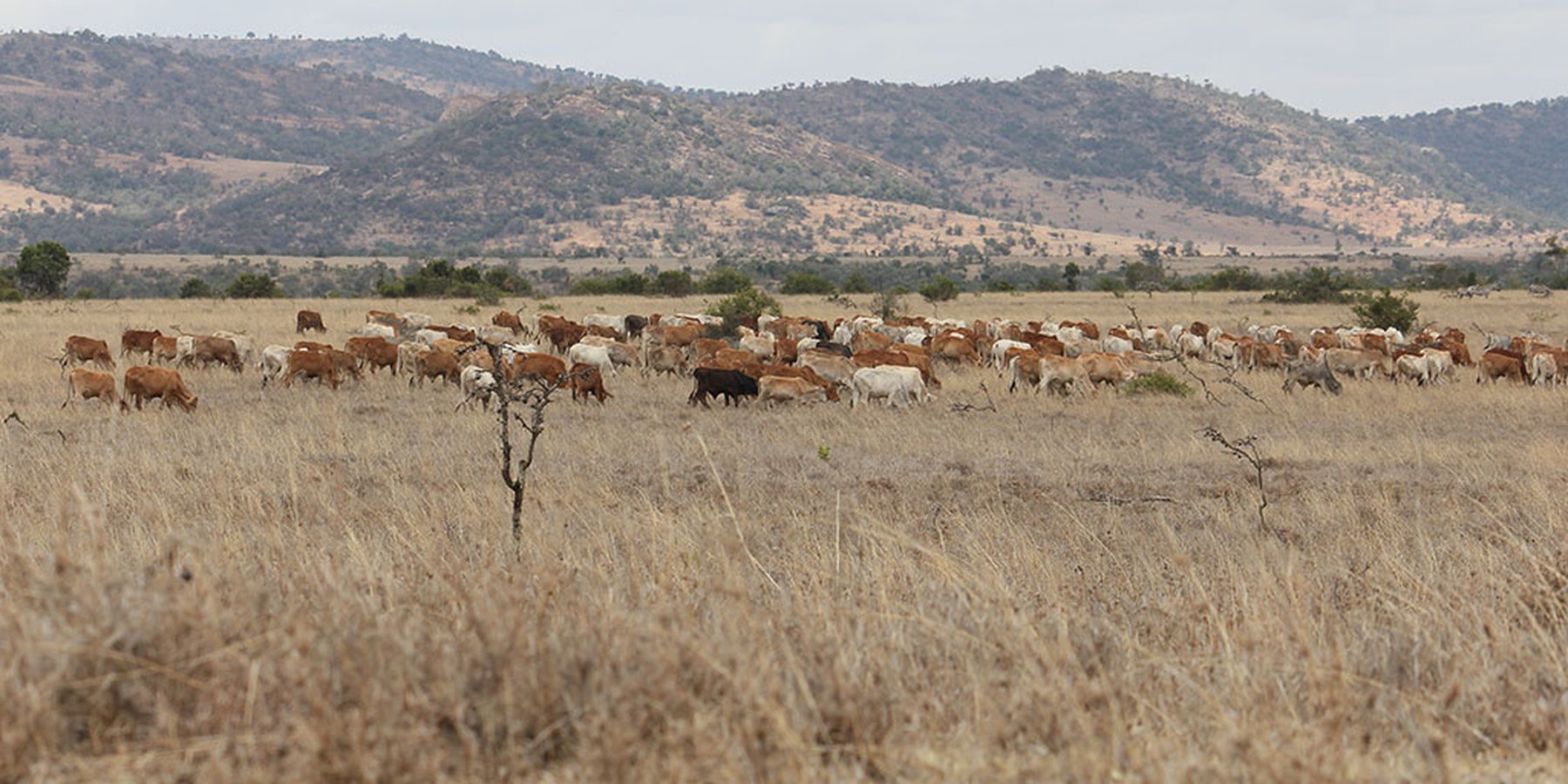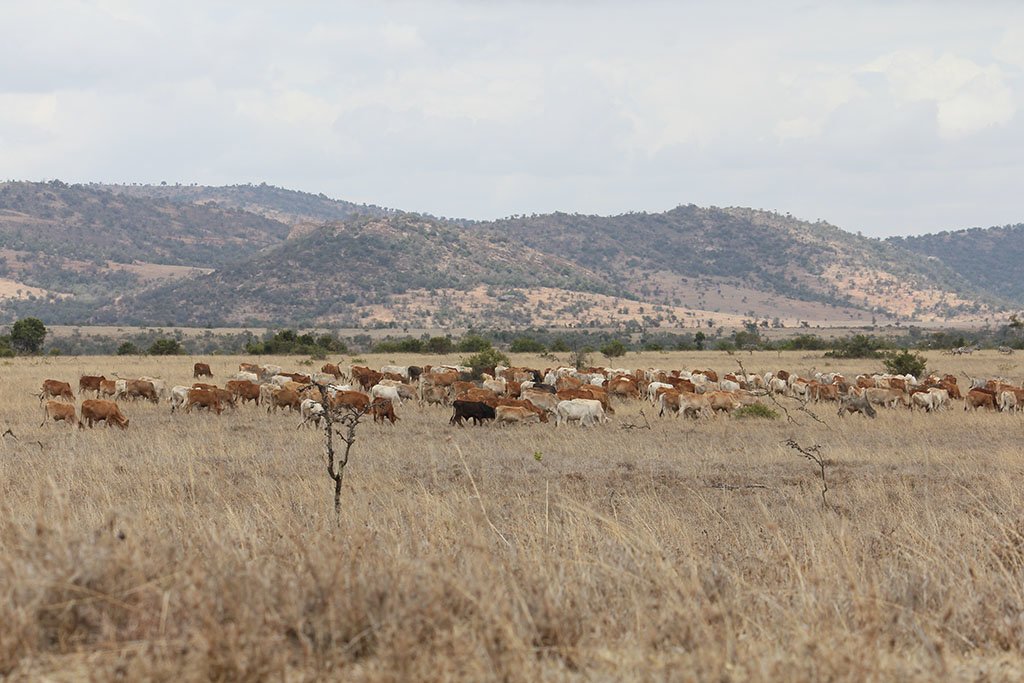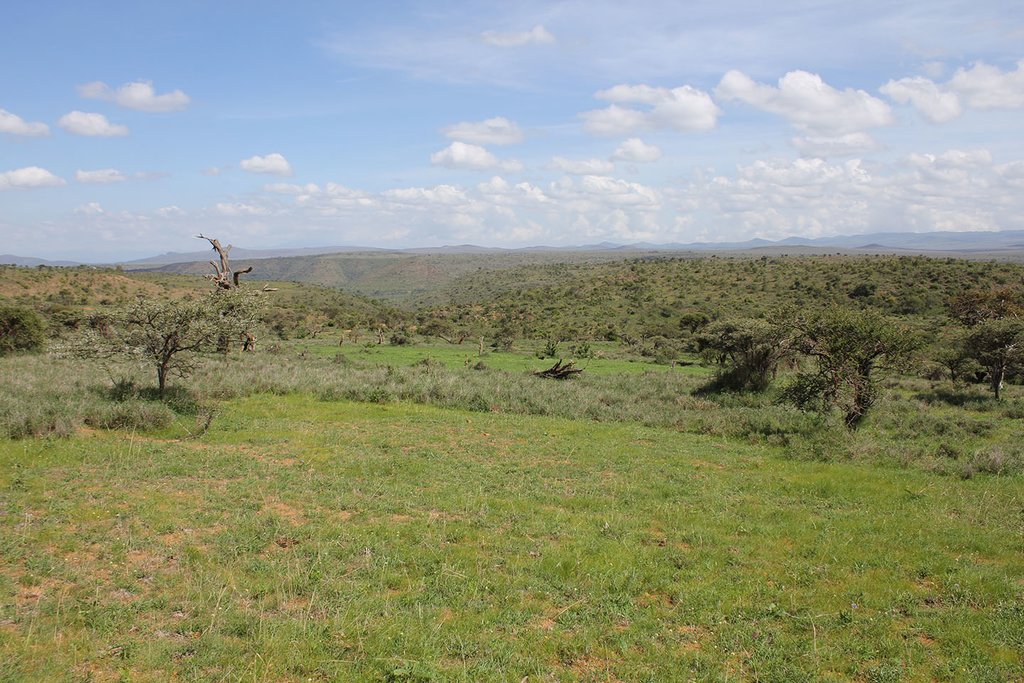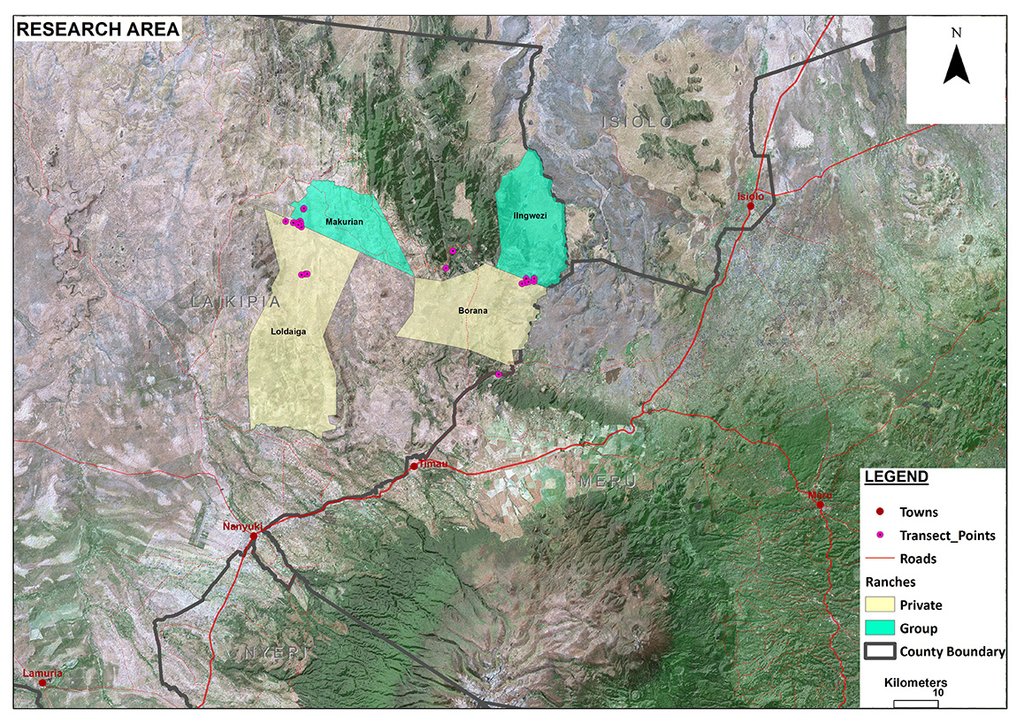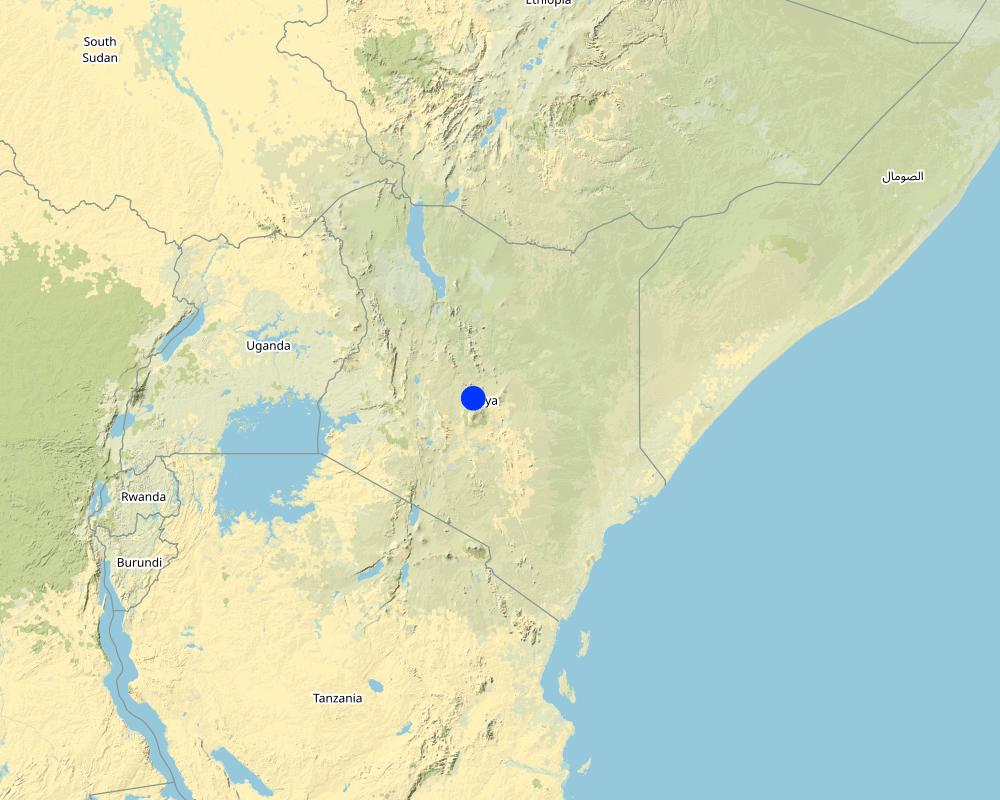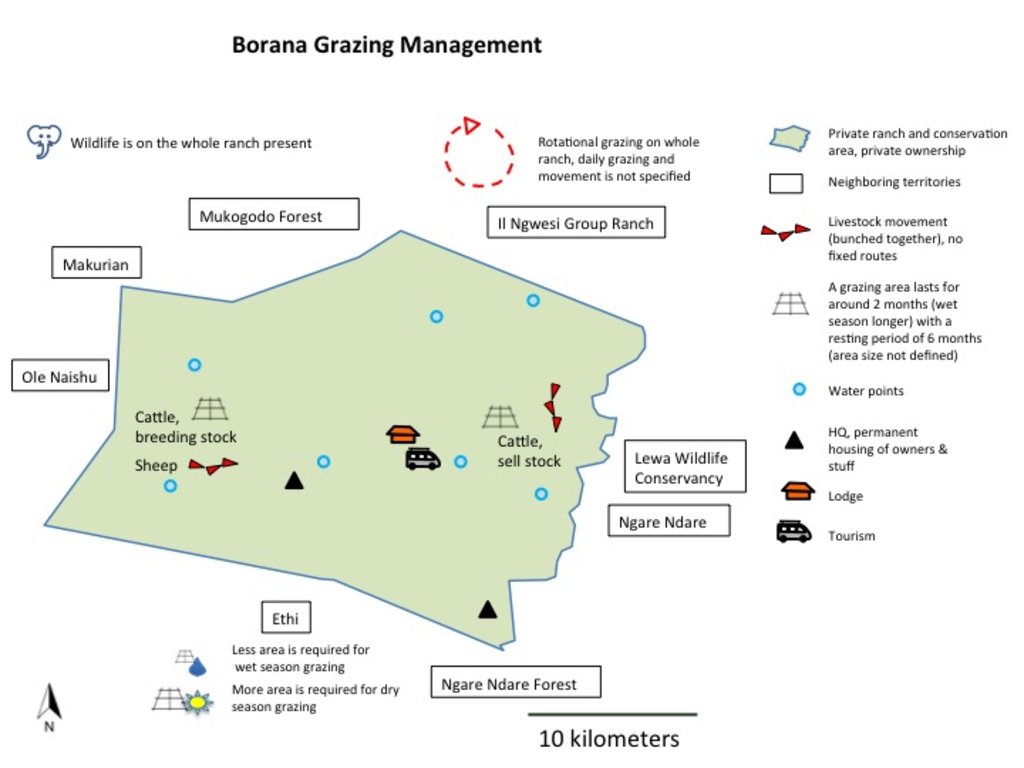Borana Ranch Grazing with Holistic Management Principles [เคนยา]
- ผู้สร้างสรรค์:
- การอัพเดท:
- ผู้รวบรวม: Michael Herger
- ผู้เรียบเรียง: –
- ผู้ตรวจสอบ: Alexandra Gavilano, Rima Mekdaschi Studer, Hanspeter Liniger, Donia Mühlematter, Joana Eichenberger
technologies_2972 - เคนยา
- บทสรุปทั้งหมดในรูปแบบของ PDF
- บทสรุปทั้งหมดในรูปแบบของ PDF เพื่อพิมพ์
- บทสรุปทั้งหมดในรูปหน้าเว็บ
- บทสรุปทั้งหมด (ไม่มีการจัดเรียง)
- Borana Ranch Grazing with Holistic Management Principles: 3 กันยายน 2018 (inactive)
- Borana Ranch Grazing with Holistic Management Principles: 6 พฤษภาคม 2019 (inactive)
- Borana Ranch Grazing with Holistic Management Principles: 2 พฤศจิกายน 2021 (public)
- Borana Ranch Grazing with Holistic Management Principles: 22 กุมภาพันธ์ 2018 (inactive)
- Borana Ranch Grazing with Holistic Management Principles: 1 กุมภาพันธ์ 2018 (inactive)
ดูส่วนย่อย
ขยายทั้งหมด ย่อทั้งหมด1. ข้อมูลทั่วไป
1.2 รายละเอียดที่ติดต่อได้ของผู้รวบรวมและองค์กรที่เกี่ยวข้องในการประเมินและการจัดเตรียมทำเอกสารของเทคโนโลยี
วิทยากรหลัก
ผู้ใช้ที่ดิน:
Sora Abdi
Borana Ranch ltd. and Borana Conservancy ltd.
เคนยา
ชื่อของโครงการซึ่งอำนวยความสะดวกในการทำเอกสารหรือการประเมินเทคโนโลยี (ถ้าเกี่ยวข้อง)
Book project: Guidelines to Rangeland Management in Sub-Saharan Africa (Rangeland Management)1.3 เงื่อนไขการใช้ข้อมูลที่ได้บันทึกผ่านทาง WOCAT
ผู้รวบรวมและวิทยากรหลักยอมรับเงื่อนไขเกี่ยวกับการใช้ข้อมูลที่ถูกบันทึกผ่านทาง WOCAT:
ใช่
1.4 การเปิดเผยเรื่องความยั่งยืนของเทคโนโลยีที่ได้อธิบายไว้
เทคโนโลยีที่ได้อธิบายไว้นี้เป็นปัญหาของความเสื่อมโทรมโทรมของที่ดินหรือไม่ จึงไม่ได้รับการยอมรับว่าเป็นเทคโนโลยีเพื่อการจัดการที่ดินอย่างยั่งยืน:
ไม่ใช่
2. การอธิบายลักษณะของเทคโนโลยี SLM
2.1 การอธิบายแบบสั้น ๆ ของเทคโนโลยี
คำจำกัดความของเทคโนโลยี:
Borana is a private ranch which combines livestock production with conservation and tourism. "Holistic Management" is applied as a principle for livestock on semi-arid lands with limited water resources. Grazing comprises “bunching” and rotational movement of all animals in herds.
2.2 การอธิบายแบบละเอียดของเทคโนโลยี
คำอธิบาย:
Livestock production on Borana ranch is carried out under extensive grazing for beef, dairy, and sheep production. There is strategic fattening and offtake for sales in harmony with conservation principles. The Borana Conservancy is a non-profit organisation, also belonging to the ranch – on the same land - dedicated to the sustainable conservation of critical habitat and wildlife. Ranching contributes financially to the running of the conservancy.
“Holistic Management” (HM) as described by Allan Savory (1988) and promoted by Laikipia Wildlife Forum in Laikipia, is a method that integrates decision-making, planning, and livestock keeping. On the land, this means bunching of all livestock close together in order to act as a "plough" and break the soil to help incorporate seeds and nutrients. Water also infiltrates better. The aim is to improve plant growth and thus soil. Furthermore, it means moving the animals together from block to block, by planned rotational grazing with resting periods. HM aims at managing high numbers of livestock and simultaneously restoring degraded land. However, Holistic Management principles remain controversial.
Livestock herders employed by Borana move different herds of animals rotationally from one grazing area to the next. A defined grazing area lasts for around two months, with a resting period of six months. However, the grazing area and period vary a lot depending on rainfall. During the wet season, livestock usually spend more than two months within the same block. Cattle herds are split depending on their function as offtake for sales, or as breeding stock. The selling stock is located on the eastern side of Borana (currently 600 Head of cattle), while the breeding stock is on the western side (currently 1,800 Head of cattle). Sheep are grazed on the western side too (currently 1,200 Head of cattle).
A calf stays with its mother until it is about six months old. Then a few males are selected as bulls, and all others castrated. At the same time females are selected for breeding to rebuild stock. Only one bull was purchased from outside, in 2013 which was a rare exception.
Livestock are sold to butchers in local centres (e.g. Nanyuki, about 50 km distance), in the capital Nairobi (about 300 km away), and to the son of the owner, who runs a business nearby. Usually, only old and disabled cows are selected for selling.
Borana helps neighbouring group ranches with improved genetics - and access to their land for fattening purpose. It also acts as a grass bank during droughts. According to Borana management, boundaries between Borana and community ranches, which once clearly defined the difference between managed and over-grazed lands, are becoming less clear.
Typical of private ranches in Laikipia, Borana supports some of the highest densities of wildlife in Kenya. The wild herbivore biomass density on private ranches is estimated by Georgiadis (2007) at 14 ha /TLU.
2.3 รูปภาพของเทคโนโลยี
2.5 ประเทศภูมิภาค หรือสถานที่ตั้งที่เทคโนโลยีได้นำไปใช้และได้รับการครอบคลุมโดยการประเมินนี้
ประเทศ:
เคนยา
ภูมิภาค/รัฐ/จังหวัด:
Laikipia
ข้อมูลจำเพาะเพิ่มเติมของสถานที่ตั้ง :
Mukogodo District
ระบุการกระจายตัวของเทคโนโลยี:
- กระจายไปอย่างสม่ำเสมอในพื้นที่
If precise area is not known, indicate approximate area covered:
- 100-1,000 ตร.กม.
Map
×2.6 วันที่การดำเนินการ
ระบุปีที่ใช้:
2008
2.7 คำแนะนำของเทคโนโลยี
ให้ระบุว่าเทคโนโลยีถูกแนะนำเข้ามาอย่างไร:
- ทางโครงการหรือจากภายนอก
ความคิดเห็น (ประเภทของโครงการ เป็นต้น) :
Holistic Management approach by Allan Savory.
In Laikipia, it was introduced by Richard Hartfield, Laikipia Wildlife Forum and funded by Laikipia Wildlife Forum (LWF), Lewa Conservancy and Northern Rangeland Trust (NRT). Borana beared costs themselves.
3. การจัดประเภทของเทคโนโลยี SLM
3.1 วัตถุประสงค์หลักของเทคโนโลยี
- ปรับปรุงการผลิตให้ดีขึ้น
- ลด ป้องกัน ฟื้นฟู การเสื่อมโทรมของที่ดิน
- อนุรักษ์ระบบนิเวศน์
- รักษาสภาพหรือปรับปรุงความหลากหลายทางชีวภาพ
3.2 ประเภทของการใช้ที่ดินในปัจจุบันที่ได้นำเทคโนโลยีไปใช้

ทุ่งหญ้าเลี้ยงสัตว์
Extensive grazing:
- การทำฟาร์มปศุสัตว์ (Ranching)
Animal type:
- cattle - dairy
- cattle - non-dairy beef
- poultry
- sheep
- swine
ผลิตภัณฑ์และบริการ:
- meat
- milk
Species:
sheep
Count:
1000

การตั้งถิ่นฐาน โครงสร้างพื้นฐาน
- การตั้งถิ่นฐาน ตึกอาคาร
ข้อสังเกต:
Lodge for Tourism.
Headquarter.
แสดงความคิดเห็น:
Main animal species and products: Livestock: Cattle, sheep, chicken, pigs. Milk, beef and sheep production (a few chicken and pigs). Some organic farming (herbs, vegetables). Local (30%), national and partly international distribution (both 70%). Livestock: 1,780 TLU; Stocking rate: 7.3 ha/TLU Pressure on land including wildlife: 4.8 ha/TLU Livestock numbers: 2,400 cattle, 1,000 sheep Sales: Cattle 10% sales, Sheep 25%. Assisting community grazing: 500-1,000 Head of cattle during droughts until it rains. Wildlife: giraffe, antelope/gazelle (e.g. gerenuk, eland, waterbuck, impala, Thomson's gazelle), baboon, zebra, dikdik, hare, rhino, elephant, predators and others. There is more wildlife than on group ranches.
Number of growing seasons per year: 2
Short rains in November and December. Long rains in April and May. Rains from (October) November to December are usually better in this area. Rainfalls with strong local variations and changing regimes.
Livestock density: Livestock: 1780 TLU; Stocking rate: 7.3 ha/TLU livestock but overall pressure on land including wildlife: 4.8 ha/TLU
3.4 การใช้น้ำ
การใช้น้ำของที่ดินที่มีการใช้เทคโนโลยีอยู่:
- จากน้ำฝน
3.5 กลุ่ม SLM ที่ตรงกับเทคโนโลยีนี้
- การจัดการปศุสัตว์และทุ่งหญ้าเลี้ยงสัตว์
- การปรับปรุงดิน / พืชคลุมดิน
3.6 มาตรการ SLM ที่ประกอบกันเป็นเทคโนโลยี

มาตรการอนุรักษ์ด้วยการจัดการ
- M2: การเปลี่ยนแปลงของการจัดการหรือระดับความเข้มข้น
- M4: การเปลี่ยนแปลงช่วงเวลาให้เหมาะแก่การทำกิจกรรม
3.7 รูปแบบหลักของการเสื่อมโทรมของที่ดินที่ได้รับการแก้ไขโดยเทคโนโลยี

การกัดกร่อนของดินโดยน้ำ
- Wt (Loss of topsoil): การสูญเสียดินชั้นบนหรือการกัดกร่อนที่ผิวดิน
- Wg (Gully erosion): การกัดกร่อนแบบร่องธารหรือการทำให้เกิดร่องน้ำเซาะ

การกัดกร่อนของดินโดยลม
- Et (Loss of topsoil): การสูญเสียดินชั้นบน

การเสื่อมโทรมของดินทางด้านกายภาพ
- Pc (Compaction): การอัดแน่น
- Pk (Slaking and crusting): การอุดตันของช่องว่างในดินหรือรูพรุน
- Pi (Soil sealing)

การเสื่อมโทรมของดินทางด้านชีวภาพ
- Bc (Reduction of vegetation cover): การลดลงของจำนวนพืชที่ปกคลุมดิน
- Bh (Loss of habitat): การสูญเสียแหล่งที่อยู่
- Bq (Quantity/biomass decline): การลดลงของปริมาณหรือมวลชีวภาพ
- Bs (Quality and species composition): องค์ประกอบหรือความหลากหลายทางคุณภาพและชนิดพันธุ์ลดลง
- Bl (Loss of soil life): การสูญเสียสิ่งมีชีวิตในดิน
แสดงความคิดเห็น:
Across the grasslands and rangelands, an increase in bare land and bush has been a clear trend all over Laikipia for many years, both on community-owned lands and private ranches. Major identified ecological problems (partly) caused by livestock production are: bare ground, low contents of soil organic carbon and plant-available nutrients, soil erosion (sealing, crusting, rills and gullies, water flow patterns, sheet erosion, pedestals), poor soil properties, undesirable species, and (increasing) woody and invasive species. The technology aims at improving vegetation cover of the land and thereby reducing further degradation and restoring degraded land. Borana is clearly not as much affected by the degradation of the land (compare Herger 2018), however, they use and support ranching with Holistic Management as a tool to enhance the quality of the grazing and prevent degradation. According to Borana management, cattle grazing reduces the moribund grass biomass, promotes seed dispersal, increases the nutritional value of the grass, and decreases the risk of bush fires. Even more crucial: The introduction of planned grazing (as Holistic Management) to Group Ranches in the area prevents conflicts (e.g. invading of private ranches), livestock diseases and deaths.
3.8 การป้องกัน การลดลง หรือการฟื้นฟูความเสื่อมโทรมของที่ดิน
ระบุเป้าหมายของเทคโนโลยีกับความเสื่อมโทรมของที่ดิน:
- ป้องกันความเสื่อมโทรมของที่ดิน
- ลดความเสื่อมโทรมของดิน
4. ข้อมูลจำเพาะด้านเทคนิค กิจกรรมการนำไปปฏิบัติใช้ ปัจจัยนำเข้า และค่าใช้จ่าย
4.1 แบบแปลนทางเทคนิคของเทคโนโลยี
4.2 ข้อมูลทั่วไปเกี่ยวกับการคำนวณปัจจัยนำเข้าและค่าใช้จ่าย
ให้ระบุว่าค่าใช้จ่ายและปัจจัยนำเข้าได้รับการคำนวณอย่างไร:
- ต่อหน่วยเทคโนโลยี
โปรดระบุหน่วย:
Only livestock production related; for the whole farm: Herders, animals treatment
ระบุสกุลเงินที่ใช้คำนวณค่าใช้จ่าย:
- USD
ระบุค่าเฉลี่ยของค่าจ้างในการจ้างแรงงานต่อวัน:
4
4.3 กิจกรรมเพื่อการจัดตั้ง
| กิจกรรม | Timing (season) | |
|---|---|---|
| 1. | Training of employees | |
| 2. | Grazing planning |
4.4 ค่าใช้จ่ายของปัจจัยนำเข้าที่จำเป็นสำหรับการจัดตั้ง
แสดงความคิดเห็น:
No figures on this, costs for implementation are estimated low, because ranching with the former grazing system was not that different before.
4.5 การบำรุงรักษาสภาพหรือกิจกรรมที่เกิดขึ้นเป็นประจำ
| กิจกรรม | ช่วงระยะเวลา/ความถี่ | |
|---|---|---|
| 1. | Herders, supervisors, watchmen etc | |
| 2. | Animal treatments (vaccination, spraying, injections) |
4.6 ค่าใช้จ่ายของปัจจัยนำเข้าและกิจกรรมที่เกิดขึ้นเป็นประจำที่ต้องการการบำรุงรักษา (ต่อปี)
| ปัจจัยนำเข้า | หน่วย | ปริมาณ | ค่าใช้จ่ายต่อหน่วย | ค่าใช้จ่ายทั้งหมดต่อปัจจัยนำเข้า | %ของค่าใช้จ่ายที่ก่อให้เกิดขึ้นโดยผู้ใช้ที่ดิน | |
|---|---|---|---|---|---|---|
| แรงงาน | Herders/employees | Person*days | 16200.0 | 4.0 | 64800.0 | 100.0 |
| แรงงาน | Insurance | Unknown quantity | 1.0 | 3900.0 | 3900.0 | |
| อุปกรณ์ | Vehicle | Unknown quantity | 1.0 | 3700.0 | 3700.0 | |
| อื่น ๆ | Animals treatments | Per TLU | 1780.0 | 11.0 | 19580.0 | |
| ค่าใช้จ่ายทั้งหมดของการบำรุงรักษาสภาพเทคโนโลยี | 91980.0 | |||||
| Total costs for maintenance of the Technology in USD | 91980.0 | |||||
4.7 ปัจจัยสำคัญที่สุดที่มีผลกระทบต่อค่าใช้จ่าย
ปัจจัยสำคัญที่สุดที่มีผลกระทบต่อค่าใช้จ่ายต่างๆ:
Labor
5. สิ่งแวดล้อมทางธรรมชาติและของมนุษย์
5.1 ภูมิอากาศ
ฝนประจำปี
- < 250 ม.ม.
- 251-500 ม.ม.
- 501-750 ม.ม.
- 751-1,000 ม.ม.
- 1,001-1,500 ม.ม.
- 1,501-2,000 ม.ม.
- 2,001-3,000 ม.ม.
- 3,001-4,000 ม.ม.
- > 4,000 ม.ม.
ระบุปริมาณน้ำฝนเฉลี่ยรายปี (ถ้ารู้) :หน่วย ม.ม.
497.00
ข้อมูลจำเพาะ/ความคิดเห็นเรื่องปริมาณน้ำฝน:
Rainfall gauge Borana HQ average from 2013-2016. Strong local (and temporal) variation, changing rainfall regimes.
ระบุชื่อของสถานีตรวดวัดอากาศที่ใช้อ้างอิงคือ:
Rainfall gauge Borana HQ
เขตภูมิอากาศเกษตร
- กึ่งแห้งแล้ง
5.2 สภาพภูมิประเทศ
ค่าเฉลี่ยความลาดชัน:
- ราบเรียบ (0-2%)
- ลาดที่ไม่ชัน (3-5%)
- ปานกลาง (6-10%)
- เป็นลูกคลื่น (11-15%)
- เป็นเนิน (16-30%)
- ชัน (31-60%)
- ชันมาก (>60%)
ธรณีสัณฐาน:
- ที่ราบสูง/ที่ราบ
- สันเขา
- ไหล่เขา
- ไหล่เนินเขา
- ตีนเนิน
- หุบเขา
ระดับความสูง:
- 0-100 เมตร
- 101-500 เมตร
- 501-1,000 เมตร
- 1,001-1,500 เมตร
- 1,501-2,000 เมตร
- 2,001-2,500 เมตร
- 2,501-3,000 เมตร
- 3,001-4,000 เมตร
- > 4,000 เมตร
ให้ระบุถ้าเทคโนโลยีได้ถูกนำไปใช้:
- ไม่เกี่ยวข้อง
5.3 ดิน
ค่าเฉลี่ยความลึกของดิน:
- ตื้นมาก (0-20 ซ.ม.)
- ตื้น (21-50 ซ.ม.)
- ลึกปานกลาง (51-80 ซ.ม.)
- ลึก (81-120 ซ.ม.)
- ลึกมาก (>120 ซ.ม.)
เนื้อดิน (ดินชั้นบน):
- หยาบ/เบา (ดินทราย)
- ปานกลาง (ดินร่วน ทรายแป้ง)
เนื้อดินล่าง (> 20 ซ.ม.ต่ำจากผิวดิน):
- หยาบ/เบา (ดินทราย)
- ปานกลาง (ดินร่วน ทรายแป้ง)
อินทรียวัตถุในดิน:
- ปานกลาง (1-3%)
(ถ้ามี) ให้แนบคำอธิบายเรื่องดินแบบเต็มหรือระบุข้อมูลที่มีอยู่ เช่น ชนิดของดิน ค่า pH ของดินหรือความเป็นกรดของดิน ความสามารถในการแลกเปลี่ยนประจุบวก ไนโตรเจน ความเค็ม เป็นต้น:
Red and brown sandy soils. Black cotton soil. Luvisol, Regosol, Vertisol
SOC 2 %
pH: 6.4
Clay: 8%
Silt: 53%
Sand: 39%
Further data on rangeland health compare Herger (2018)
5.4 ความเป็นประโยชน์และคุณภาพของน้ำ
ระดับน้ำใต้ดิน:
> 50 เมตร
น้ำไหลบ่าที่ผิวดิน:
ปานกลาง
คุณภาพน้ำ (ที่ยังไม่ได้บำบัด):
เป็นน้ำเพื่อการดื่มที่ไม่ดี (จำเป็นต้องได้รับการบำบัด)
ความเค็มของน้ำเป็นปัญหาหรือไม่:
ไม่ใช่
กำลังเกิดน้ำท่วมในพื้นที่หรือไม่:
ไม่ใช่
ความคิดเห็นและข้อมูลจำเพาะเพิ่มเติมเรื่องคุณภาพและปริมาณน้ำ:
Waterpoints provided by waterpipes (sometimes destroyed by elephants)
5.5 ความหลากหลายทางชีวภาพ
ความหลากหลายทางชนิดพันธุ์:
- สูง
ความหลากหลายของแหล่งที่อยู่:
- สูง
ความคิดเห็นและข้อมูลจำเพาะเพิ่มเติมของความหลากหลายทางชีวภาพ:
Grassed acacia bushland. Little bare ground. Dominant grasses: Eragrostis species, Cynadon species, Hyparrhenia species, Kelenger species. Dominant shrubs: Grewia tembensis, Hibiscus aponeurus, Rhus natalensis, Scutia myrtina. Dominant trees: Acacia tortilis, Acacia mellifera, Euclea divinorum, Boscia angustifolia. Detailed list of all species (also wildlife) available (Herger 2018)
5.6 ลักษณะของผู้ใช้ที่ดินที่นำเทคโนโลยีไปปฏิบัติใช้
อยู่กับที่หรือเร่ร่อน:
- อยู่กับที่
แนวทางการตลาดของระบบการผลิต:
- ทำการค้า/การตลาด
รายได้ที่มาจากนอกฟาร์ม:
- 10-50% ของรายได้ทั้งหมด
ระดับของความมั่งคั่งโดยเปรียบเทียบ:
- รวยมาก
เป็นรายบุคคล/ครัวเรือน:
- เป็นรายบุคคล/ครัวเรือน
ระดับของการใช้เครื่องจักรกล:
- งานที่ใช้แรงกาย
เพศ:
- หญิง
- ชาย
อายุของผู้ใช้ที่ดิน:
- วัยกลางคน
5.7 Average area of land used by land users applying the Technology
- < 0.5 เฮกตาร์
- 0.5-1 เฮกตาร์
- 1-2 เฮกตาร์
- 2-5 เฮกตาร์
- 5-15 เฮกตาร์
- 15-50 เฮกตาร์
- 50-100 เฮกตาร์
- 100-500 เฮกตาร์
- 500-1,000 เฮกตาร์
- 1,000-10,000 เฮกตาร์
- >10,000 เฮกตาร์
พิจารณาว่าเป็นขนาดเล็ก กลาง หรือขนาดใหญ่ (ซึ่งอ้างอิงถึงบริบทระดับท้องถิ่น):
- ขนาดใหญ่
5.8 กรรมสิทธิ์ในที่ดิน สิทธิในการใช้ที่ดินและสิทธิในการใช้น้ำ
กรรมสิทธิ์ในที่ดิน:
- รายบุคคล ได้รับสิทธิครอบครอง
สิทธิในการใช้ที่ดิน:
- รายบุคคล
สิทธิในการใช้น้ำ:
- รายบุคคล
แสดงความคิดเห็น:
Masai in the area have claimed that land leases of white settlers have expired and the land belongs to them. Government states the land belongs to the private ranchers, but the future development is unknown. There have already been conflicts and are likely to happen again. On the other hand, cooperation with group ranches has increased.
5.9 การเข้าถึงบริการและโครงสร้างพื้นฐาน
สุขภาพ:
- จน
- ปานกลาง
- ดี
การศึกษา:
- จน
- ปานกลาง
- ดี
ความช่วยเหลือทางด้านเทคนิค:
- จน
- ปานกลาง
- ดี
การจ้างงาน (เช่น ภายนอกฟาร์ม):
- จน
- ปานกลาง
- ดี
ตลาด:
- จน
- ปานกลาง
- ดี
พลังงาน:
- จน
- ปานกลาง
- ดี
ถนนและการขนส่ง:
- จน
- ปานกลาง
- ดี
น้ำดื่มและการสุขาภิบาล:
- จน
- ปานกลาง
- ดี
บริการด้านการเงิน:
- จน
- ปานกลาง
- ดี
6. ผลกระทบและสรุปคำบอกกล่าว
6.1 ผลกระทบในพื้นที่ดำเนินการ (On-site) จากการใช้เทคโนโลยี
ผลกระทบทางด้านเศรษฐกิจและสังคม
การผลิต
การผลิตพืชที่ใช้เลี้ยงปศุสัตว์
แสดงความคิดเห็น/ระบุ:
Quality of pasture
การผลิตสัตว์
แสดงความคิดเห็น/ระบุ:
Better quality of animals
การจัดการที่ดิน
ความเป็นประโยชน์และคุณภาพของน้ำ
การมีน้ำไว้ให้ปศุสัตว์
คุณภาพน้ำสำหรับปศุสัตว์
รายได้และค่าใช้จ่าย
ภาระงาน
ผลกระทบด้านสังคมวัฒนธรรมอื่น ๆ
การใช้ที่ดิน / สิทธิในการใช้น้ำ
แสดงความคิดเห็น/ระบุ:
Cooperation with Group Ranches
SLM หรือความรู้เรื่องความเสื่อมโทรมของที่ดิน
การบรรเทาความขัดแย้ง
แสดงความคิดเห็น/ระบุ:
Good: Cooperation with Group Ranches. But still danger of invaders. Good pasture attracts herders in distress (e.g. pastoralists from further north)
ผลกระทบด้านนิเวศวิทยา
วัฐจักรน้ำหรือน้ำบ่า
ปริมาณน้ำ
คุณภาพน้ำ
น้ำไหลบ่าที่ผิวดิน
การระเหย
ดิน
ความชื้นในดิน
สิ่งปกคลุมดิน
การสูญเสียดิน
อินทรียวัตถุในดิน/ต่ำกว่าดินชั้น C
ความหลากหลายทางชีวภาพของพืชและสัตว์
การปกคลุมด้วยพืช
มวลชีวภาพ/เหนือดินชั้น C
ความหลากหลายทางชีวภาพของพืช
ความหลากหลายทางชีวภาพของสัตว์
ความหลากหลายของสัตว์
ลดความเสี่ยงของภัยพิบัติ
ผลกระทบจากภัยแล้ง
6.4 การวิเคราะห์ค่าใช้จ่ายและผลประโยชน์ที่ได้รับ
ผลประโยชน์ที่ได้รับเปรียบเทียบกับค่าใช้จ่ายในการจัดตั้งเป็นอย่างไร (จากมุมมองของผู้ใช้ที่ดิน)
ผลตอบแทนระยะสั้น:
เป็นกลางหรือสมดุล
ผลตอบแทนระยะยาว:
ด้านบวก
ผลประโยชน์ที่ได้รับเปรียบเทียบกับค่าใช้จ่ายในการบำรุงรักษาหรือต้นทุนที่เกิดขึ้นซ้ำอีก เป็นอย่างไร (จากมุมมองของผู้ใช้ที่ดิน)
ผลตอบแทนระยะสั้น:
ด้านบวก
ผลตอบแทนระยะยาว:
ด้านบวก
6.5 การปรับตัวของเทคโนโลยี
- 11-50%
Of all those who have adopted the Technology, how many did so spontaneously, i.e. without receiving any material incentives/ payments?
- 11-50%
6.6 การปรับตัว
เทคโนโลยีได้รับการปรับเปลี่ยนเมื่อเร็วๆนี้ เพื่อให้ปรับตัวเข้ากับสภาพที่กำลังเปลี่ยนแปลงหรือไม่:
ไม่ใช่
6.7 จุดแข็ง / ข้อได้เปรียบ / โอกาสของเทคโนโลยี
| จุดแข็ง / ข้อได้เปรียบ / โอกาสในทัศนคติของผู้ใช้ที่ดิน |
|---|
| Method leaves grass time to grow/rest |
| One can manage resources properly (water and pasture) |
| To keep all animals in one place makes vaccinations /disease prevention easier |
| “Ploughing effect” by the concentrated / bunched animals in one herd (new grass stimulated) |
| Tick population kept under control |
| In general for the whole area if many Group Ranches implement Holistic Management: More secure financial future and less stress during times of drought for pastoralists’ livestock. For Borana, this means less pressure from surrounding pastoralists when pasture is scarce. |
| Enhance the quality of grazing. Cattle grazing reduces the moribund grass biomass, promotes seed dispersal, increases the nutritional value of the grass and decreases the risk of bush fires. |
| จุดแข็ง / ข้อได้เปรียบ / โอกาสในทัศนคติของผู้รวบรวมหรือวิทยากรหลัก |
|---|
| The listed advantages from Abdi Sora, land user, are for the most part shared by the compiler's view. Regarding Holistic Management (HM) principles and land recovery there remain some uncertainties. On the one hand it is generally questionable to state as in HM that: “the more animals the better” (as long as they are managed properly they can even recover degraded land), but this seems dangerous in areas with such high livestock numbers and cultural value of livestock keeping - without scientific proof of the principles in similar ecological conditions. Since Borana has relatively low stocking rates and good management the rangeland is in good condition anyway. The effects of Holistic Management principles on their own are difficult to estimate. |
6.8 จุดอ่อน / ข้อเสียเปรียบ / ความเสี่ยงของเทคโนโลยีและวิธีการแก้ไข
| จุดอ่อน / ข้อเสียเปรียบ / ความเสี่ยงในทัศนคติของผู้ใช้ที่ดิน | มีวิธีการแก้ไขได้อย่างไร |
|---|---|
| More work (a lot of supervision, monitoring etc) | |
| More costs (a lot of supervision, monitoring etc) | |
| Danger of disease outbreak in a big herd |
7. การอ้างอิงและการเชื่อมต่อ
7.1 วิธีการและแหล่งข้อมูล
- ไปเยี่ยมชมภาคสนาม การสำรวจพื้นที่ภาคสนาม
4 field visits with included "rangeland health assessment" in different parts of Borana (mainly next to gate to Il Ngwesi) where I could see the condition of the land as well as several other visits of the area.
- การสัมภาษณ์กับผู้ใช้ที่ดิน
Several meetings with the general manager and a short meeting with the owner of the ranch.
- การสัมภาษณ์ผู้เชี่ยวชาญด้าน SLM หรือผู้ชำนาญ
Truman Young
Dan Rubenstein
Dino Martins
John Letai
Samali Letai
Peter Hetz
Dominic Maringa
Joseph Putunoi
Patrick Ekodere
- การเก็บรวบรวมมาจากรายงานและเอกสารที่มีอยู่
Scientific papers, LWF reports etc.
วันที่เก็บรวบรวมข้อมูล(ภาคสนาม) :
22/01/2017
7.2 การอ้างอิงถึงสิ่งตีพิมพ์
หัวข้อ, ผู้เขียน, ปี, หมายเลข ISBN:
Georgiadis, N.J., Olivero, I.N., Romanach, S.S. (2007). Savanna herbivore dynamics in a livestock-dominated landscape: I. Dependence on land use, rainfall, density, and time. Biology Conservation 137(3): 461-472.
ชื่อเรื่อง ผู้เขียน ปี ISBN:
Online
หัวข้อ, ผู้เขียน, ปี, หมายเลข ISBN:
Herger, M.B. (2018). Environmental Impacts of Red Meat Production. MSc Thesis. University of Bern.
ชื่อเรื่อง ผู้เขียน ปี ISBN:
University of Bern
หัวข้อ, ผู้เขียน, ปี, หมายเลข ISBN:
Savory, A (1988). Holistic Resource Management. Gilmour Publishing, Harare, Zimbabwe
ชื่อเรื่อง ผู้เขียน ปี ISBN:
Online
หัวข้อ, ผู้เขียน, ปี, หมายเลข ISBN:
•Carter, J., Jones, A., O’Brien, M., Ratner, J., Wuerthner, G. (2014). Holistic Management: Misinformation on the Science of Grazed Ecosystems.
ชื่อเรื่อง ผู้เขียน ปี ISBN:
International Journal of Biodiversity.
หัวข้อ, ผู้เขียน, ปี, หมายเลข ISBN:
•Briske, D.D., Ash, A.J., Derner, J.D., Huntsinger, L. (2014). Commentary: A critical assessment of the policy endorsement for holistic management. Agricultural Systems 125:50-53.
ลิงก์และโมดูล
ขยายทั้งหมด ย่อทั้งหมดลิงก์
ไม่มีลิงก์
โมดูล
ไม่มีโมดูล


